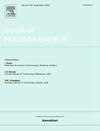基于AM-SIS-ANN方法的IRIS被动EHRS可靠性评估
IF 2.3
3区 工程技术
Q1 NUCLEAR SCIENCE & TECHNOLOGY
引用次数: 0
摘要
核电厂无源系统可靠性评估的研究是保障核电安全的关键。已经提出了许多分析方法来计算被动系统的失效概率,其中最引人注目的是将快速计算代理模型与有效的方差缩减抽样技术相结合。然而,这些方法主要是基于确定性失效标准,在管理这些标准的不确定性方面提出了重大挑战。为了解决这一问题,提高被动系统可靠性估计的准确性和效率,本文提出了一种将自适应元模型子集仿真重要性抽样(AM-SIS)与神经网络相结合的分段方法,简称AM-SIS- ann。该方法利用了两种技术的优势:使用AM-SIS方法计算低概率区域的故障概率,以减轻稀疏数据区域神经网络的高预测误差,并使用神经网络计算其他区域的输出分布,从而消除了额外执行AM-SIS的需要,并大大减少了计算时间。通过两个算例说明并验证了该方法的有效性。最后,将该方法应用于IRIS反应堆应急排热系统(EHRS)的故障概率计算。以自然循环环为例,在考虑4种失效准则的情况下,AM-SIS- ann方法的计算时间最短,比AM-SIS方法缩短约23.4%,比神经网络方法缩短约57.5%。结果表明,在不确定失效准则下,AM-SIS-ANN方法在保证较高准确率的同时,显著减少了计算时间。本文章由计算机程序翻译,如有差异,请以英文原文为准。
Reliability assessment of passive EHRS of IRIS based on the AM-SIS-ANN method
Research on the reliability estimation of passive systems in nuclear power plants has been pivotal to ensuring nuclear power generation safety. Numerous analytical methods have been proposed to calculate the failure probability of passive systems, with the most notable ones combining fast computational surrogate models with efficient variance reduction sampling techniques. Nevertheless, these methods are predominantly based on deterministic failure criteria, posing a significant challenge in managing the uncertainty of such criteria. To address this problem and enhance the accuracy and efficiency of passive system reliability estimation, this paper introduces a segmented method that integrates Adaptive Metamodel Subset Simulation Importance Sampling (AM-SIS) with neural networks, abbreviated as AM-SIS-ANN. This method harnesses the strengths of both techniques: employing the AM-SIS method to calculate failure probabilities in low-probability regions to mitigate high prediction errors from neural networks in sparse data areas, and using neural networks to compute output distributions in other regions, thereby eliminating the need for additional AM-SIS executions and substantially reducing computation time. The proposed method’s effectiveness is illustrated and validated through two numerical examples. Finally, this method is applied to calculate the failure probability of the Emergency Heat Removal System (EHRS) of the IRIS reactor. For the natural circulation loop example, considering four failure criteria, the AM-SIS-ANN method achieved the shortest computation time, reducing it by approximately 23.4% compared to the AM-SIS method and by about 57.5% compared to the neural network method. These results demonstrate that the AM-SIS-ANN method, under uncertain failure criteria, can significantly reduce computational time while ensuring high accuracy.
求助全文
通过发布文献求助,成功后即可免费获取论文全文。
去求助
来源期刊

Annals of Nuclear Energy
工程技术-核科学技术
CiteScore
4.30
自引率
21.10%
发文量
632
审稿时长
7.3 months
期刊介绍:
Annals of Nuclear Energy provides an international medium for the communication of original research, ideas and developments in all areas of the field of nuclear energy science and technology. Its scope embraces nuclear fuel reserves, fuel cycles and cost, materials, processing, system and component technology (fission only), design and optimization, direct conversion of nuclear energy sources, environmental control, reactor physics, heat transfer and fluid dynamics, structural analysis, fuel management, future developments, nuclear fuel and safety, nuclear aerosol, neutron physics, computer technology (both software and hardware), risk assessment, radioactive waste disposal and reactor thermal hydraulics. Papers submitted to Annals need to demonstrate a clear link to nuclear power generation/nuclear engineering. Papers which deal with pure nuclear physics, pure health physics, imaging, or attenuation and shielding properties of concretes and various geological materials are not within the scope of the journal. Also, papers that deal with policy or economics are not within the scope of the journal.
 求助内容:
求助内容: 应助结果提醒方式:
应助结果提醒方式:


